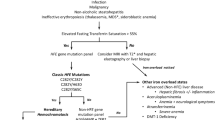Abstract
Background
There are limited data on the phenotypic differences between patients with hereditary hemochromatosis (HH) and other forms of iron overload.
Aims
To describe and compare patients suspected of having iron overload disease.
Methods
Patients were evaluated at a university iron overload clinic over a 5-year period. Biochemical and clinical profiles of patients with HH and non-HH causes of suspected iron overload were retrospectively compared.
Results
A total of 270 patients were evaluated during the enrollment period, and 137 (51%) were diagnosed with HH. The most common reasons for referral were elevated serum iron markers (155 patients), followed by positive family history (40 patients), and known HH (75 patients). In patients without HH referred for suspected iron overload, the most common diagnoses were nonalcoholic fatty liver disease (NAFLD) (24%), chronic hepatitis C infection (14%), and alcohol related liver disease (9%). Of the patients with HH, 108 were C282Y homozygotes, 20 were compound heterozygotes (C282Y/H63D), and nine had neither mutation. The following clinical characteristics were significantly different (p < 0.05) between patients with HH and all other referred patients: arthralgia (42 vs. 16%) and decreased libido (11 vs. 4%). There was a non-significant trend towards increased fatigue (44 vs. 33%), diabetes (10 vs. 6%), impotence (8 vs. 4%), and hypothyroidism (10 vs. 6%) in the HH group.
Conclusions
(1) A large proportion of patients referred for suspected iron overload have diagnoses other than HH. (2) NAFLD, chronic hepatitis C, and chronic alcohol use were the most common alternative diagnoses. (3) Arthralgia and fatigue are the most common symptoms among patients with HH.




Similar content being viewed by others
References
Gurrin LC, Osborne NJ, Constantine CC, et al. The natural history of serum iron indices for HFE C282Y homozygosity associated with hereditary hemochromatosis. Gastroenterology. 2008;135:1945–1952.
Beutler E, Felitti JVJ, Koziol JA, et al. Penetrance of the 845G → A (C282Y) HFE hereditary haemochromatosis mutation in the USA. Lancet. 2002;359:211–218.
Allen KJ, Gurrin LC, Constantine CC, et al. Iron-overload-related disease in HFE hereditary hemochromatosis. N Engl J Med. 2008;358:221–230.
Yen AW, Fancher TL, Bowlus CL. Revisiting hereditary hemochromatosis: current concepts and progress. Am J Med. 2006;119:391–399.
Alexander J, Kowdley KV. HFE-associated hereditary hemochromatosis. Genet Med. 2009;11:307–313.
Waalen J, Felitti VJ, Gelbart T, et al. Screening for hemochromatosis by measuring ferritin levels: a more effective approach. Blood. 2008;111:3373–3376.
Morrison ED, Brandhagen DJ, Phatak PD, et al. Serum ferritin level predicts advanced hepatic fibrosis among U.S. patients with phenotypic hemochromatosis. Ann Intern Med. 2003;138:627–633.
Koziol JA, Ho NJ, Felitti VJ, et al. Reference centiles for serum ferritin and percentage of transferrin saturation, with application to mutations of the HFE gene. Clin Chemo. 2001;47:1804–1810.
Wong K, Adams PC. The diversity of liver diseases among outpatient referrals for an elevated serum ferritin. Can J Gastroenterol. 2006;20:467–470.
Licata A, Nebbia ME, Cabibbo G, et al. Hyperferritinemia is a risk factor for steatosis in chronic liver disease. World J Gastroenterol. 2009;15:2132–2138.
Feder JN, Gnirke A, Thomas W, et al. A novel MHC class I-like gene is mutated in patients with hereditary haemochromatosis. Nat Genet. 1996;13:399–408.
Jouanolle AM, Fergelot P, Gandon G, et al. A candidate gene for hemochromatosis: frequency of the C282Y and H63D mutations. Hum Genet. 1997;100:544–547.
Acknowledgments
This study was supported in part by NIH grant DK02957 to Kris V. Kowdley, MD.
Competing Interests
The authors declare that they have no competing interests.
Author information
Authors and Affiliations
Corresponding author
Additional information
Authors’ contributions
J.B.D. contributed to the design, provided intellectual content, created the figures and table, and drafted the manuscript. M.A.M., J.E.M., and D.W. contributed equally by collecting and analyzing the data. K.V.K. designed the study, revised the manuscript, and provided important intellectual content. All authors read and approved the final manuscript.
Rights and permissions
About this article
Cite this article
Dever, J.B., Mallory, M.A., Mallory, J.E. et al. Phenotypic Characteristics and Diagnoses of Patients Referred to an Iron Overload Clinic. Dig Dis Sci 55, 803–807 (2010). https://doi.org/10.1007/s10620-009-1080-1
Received:
Accepted:
Published:
Issue Date:
DOI: https://doi.org/10.1007/s10620-009-1080-1




